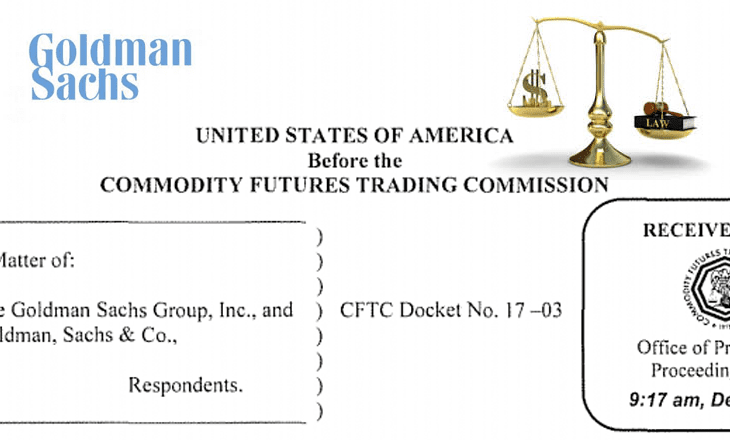The U.S. Commodity Futures Trading Commission (CFTC) issued an Order today filing and settling charges against Goldman Sachs Group Inc (NYSE:GS) and Goldman, Sachs & Co. (collectively, Goldman or the Bank).
The Order finds that, beginning in January 2007 and continuing through March 2012 (the Relevant Period), Goldman attempted, by and through certain of its traders in New York, on many occasions to manipulate and made false reports concerning the U.S. Dollar International Swaps and Derivatives Association Fix (USD ISDAFIX), a global benchmark for interest rate products.
Goldman’s unlawful conduct involved multiple traders, including the head of Goldman’s Interest Rate Products Trading Group in the United States, according to the CFTC Order.
The CFTC Order requires Goldman to pay a $120 million civil monetary penalty, cease and desist from further violations as charged, and take specified remedial steps, including measures 1) to detect and deter trading intended to manipulate swap rates such as USD ISDAFIX, 2) to ensure the integrity and reliability of the Bank’s benchmark submissions, and 3) to improve related internal controls. The Order also requires the current supervisor responsible for oversight of various United States interest-rate trading desks at Goldman to provide a certification as to, among other things, the effectiveness of the internal controls and procedures undertaken and implemented by Goldman as a result of this settlement.

Aitan Goelman,CFTC’s Director of Enforcement
Aitan Goelman, the CFTC’s Director of Enforcement said:
This matter, the third enforcement action relating to the ISDAFIX benchmark, demonstrates the breadth of this kind of misconduct across the industry, and within Goldman, the extent of the misconduct across trading desks and product lines.
The Division will continue to be vigilant and aggressive in protecting the integrity of the ISDAFIX and other important benchmarks relied upon by the markets.
Goldman, through its traders, bid, offered, and executed transactions in interest rate swap spreads, U.S. Treasuries, and Eurodollar futures contracts in a manner deliberately designed—in timing, price, and other respects—to influence the published USD ISDAFIX in order to benefit the Bank in its derivatives positions, according to the Order. In addition, Goldman, through its employees making the Bank’s USD ISDAFIX submissions, also attempted to manipulate and made false reports concerning USD ISDAFIX by skewing the Bank’s submissions in order to benefit the Bank at the expense of its derivatives counterparties and clients.
USD ISDAFIX
ISDAFIX rates and spreads are among the leading benchmarks for interest rate swaps and related derivatives, indicating the prevailing, daily market rate for the fixed leg of a standard fixed-for-floating interest rate swap in various currencies. USD ISDAFIX rates and spreads are published daily (now under a different name and methodology) for various maturities of U.S. Dollar-denominated swaps. The USD ISDAFIX rate is used for valuing cash settlement of options on interest rate swaps, or swaptions, and as a valuation tool for a wide range of products across financial markets.
For example, during the Relevant Period, USD ISDAFIX was used in settlement of exchange-traded interest rate swap futures contracts and as a component in the calculation of various constant maturity swaps, spreadlocks, proprietary interest rate indexes, and other structured products. Many parties, including pension funds and local and state governments in the United States, rely on such instruments based on USD ISDAFIX to hedge against changes in interest rates.
During the Relevant Period, USD ISDAFIX was set each day in a process that began at exactly 11:00 a.m. Eastern Time with the capture and recording of swap rates and spreads from a U.S.-based unit of a leading interest rate swaps broking firm, which disseminated the rates and spreads captured in this 11:00 a.m. “snapshot,” “fix,” or “print”—as it was referred to by traders and brokers—to a panel of banks including Goldman. The banks then made submissions to indicate where they would each bid or offer interest rate swaps to a dealer of good credit.
Goldman’s Unlawful Conduct to Benefit Derivatives Positions
As found in the Order, Goldman attempted to manipulate USD ISDAFIX through its trading at the 11:00 a.m. fixing as well as by skewing the Bank’s submissions, in order to benefit a range of derivatives positions held by Goldman that were priced or valued against the USD ISDAFIX benchmark.
Goldman traders bid, offered, and executed transactions of swap spreads, U.S. Treasuries, and Eurodollar futures contracts at the critical 11:00 a.m. fixing time with the intent to affect the “print,” i.e., the reference rates captured at 11:00 a.m. and sent to submitting banks, and thereby to affect the published USD ISDAFIX. As captured in emails and audio recordings, when Goldman had derivatives positions settling or pricing against USD ISDAFIX, Goldman traders discussed their intent to move USD ISDAFIX in whichever direction benefitted their positions.
Goldman traders stated their manipulative goals in plain language, such as directing their swap broker to “spend what you need, but make SURE we get the print,” and even objected when their attempts to manipulate were not performed as inexpensively as possible, such as when the former head of Goldman’s swap trading desk complained, “I should control the screen without having to given [sic] some loser another [trade].”
Among themselves, Goldman traders described trades based on the manipulated USD ISDAFIX as being based on the “jacked price,” as opposed to the “fair price”; remarked that other Goldman traders had “gamed the fix” in order to benefit related positions; and strategized how best to extract the “higher value” of USD ISDAFIX cash settlements against customers who lacked Goldman’s view, as a major swap dealer, into the USD ISDAFIX setting process.
To complement these efforts, as found in the Order, on many occasions during the Relevant Period, Goldman traders made USD ISDAFIX submissions higher or lower for the purpose of benefitting derivative positions priced or valued against the benchmark. As the Order finds, these submissions by Goldman were false, misleading, or knowingly inaccurate because they did not report where Goldman would itself bid and offer swaps absent a desire to manipulate the USD ISDAFIX, but rather reflected prices that were more favorable to the Bank’s specific derivatives positions.
The Order describes multiple examples of each of these strategies for attempted manipulation and false reporting by Goldman traders during the Relevant Period.
The Order notes that prior to the latter stages of the Division’s investigation, Goldman’s cooperation was not satisfactory. Goldman did not make certain productions as expeditiously as the Division expected and initially failed to produce certain communications and documents that were potentially relevant to identifying misconduct. The Order recognizes that Goldman took remedial action to improve internal controls and policies related to ISDAFIX and its successor benchmark.
To view the official Order from the CFTC click here.
To view examples of Goldman’s USD ISDAFIX Misconduct click here.
